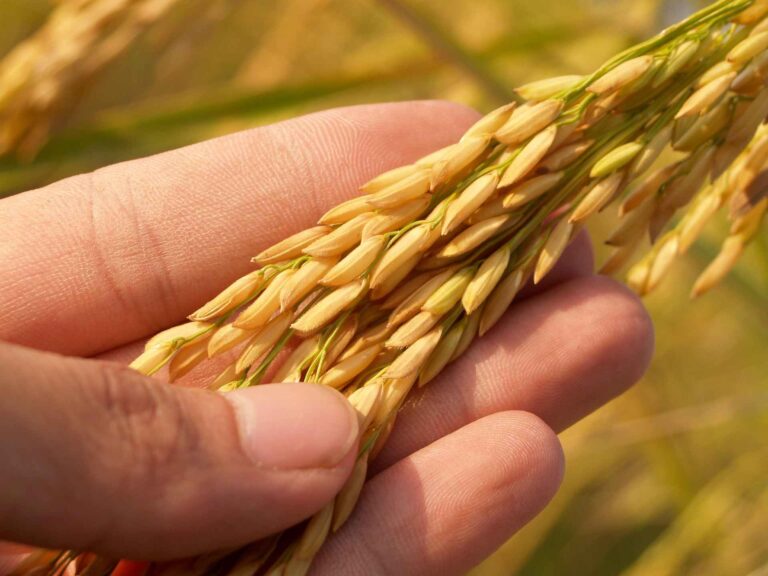13 Biggest rice producing countries in the world (2024)

Rice holds a preeminent position as a vital food staple worldwide, catering to the dietary needs of over 3.5 billion individuals on a daily basis. The ubiquity of rice cultivation is evident across the globe, with Asia at the forefront as the primary contributor and consumer of this cereal crop. The present discourse seeks to explore in-depth the topmost rice-producing nations across the world.
The world’s largest rice producing countries
| Rank | Countries | Production tons |
|---|---|---|
| 1. | China | 211,090,813 |
| 2. | India | 158,756,871 |
| 3. | Indonesia | 77,297,509 |
| 4. | Bangladesh | 52,590,000 |
| 5. | Vietnam | 43,437,229 |
| 6. | Myanmar | 25,672,832 |
| 7. | Thailand | 25,267,523 |
| 8. | Philippines | 17,627,245 |
| 9. | Brazil | 10,622,189 |
| 10. | Pakistan | 10,412,155 |
| 11. | United States of America | 10,167,050 |
| 12. | Cambodia | 9,827,001 |
| 13 | Japan | 8,044,000 |
1. China
Production: 211,090,813 tons
China has been cultivating rice for over 5,000 years and is presently the world’s top producer of this essential crop. In 2021, China is estimated to have produced approximately 211.5 million metric tons of rice.
Rice is grown in nearly all of China’s provinces, with the main producing areas located in the Yangtze River Valley, the Pearl River Delta, and the Northeastern Plains.
2. India
Production: 158,756,871 tons
In 2021, India produced an estimated 158.5 million metric tons of rice, securing its position as the second-largest rice producer globally. Rice is a vital food crop in India and is cultivated across almost every state in the country.
The prominent rice-producing states in India include West Bengal, Uttar Pradesh, Andhra Pradesh, Punjab, and Bihar. Additionally, India exports rice to various countries worldwide, with Saudi Arabia, Iran, and Iraq being the primary markets.
3. Indonesia
Production: 77,297,509 tons
Indonesia, a country situated in Southeast Asia, is renowned for its rice production, which ranks it as the world’s third-largest producer of rice. The country has an estimated production of 77.3 million metric tons of rice in 2021, with almost every region of the country engaged in rice cultivation.
Java, Sumatra, and Sulawesi are the major rice producing areas in the country. Rice is a staple food in Indonesia, and the country also exports rice to several other countries. Among the significant markets for Indonesian rice exports are Malaysia, Singapore, and the Philippines.
4. Bangladesh
Production: 52,590,000 tons
Bangladesh has become a significant contributor to global rice production, ranking as the fourth-largest producer worldwide. In the year 2021, the estimated yield of rice in the country amounted to 52.5 million metric tons.
As the most important crop in Bangladesh, rice cultivation spans across nearly every region of the nation, with major production areas situated in the Ganges-Brahmaputra Delta, Surma Valley, and Haor Basin. In addition to meeting domestic demand, Bangladesh also exports rice to numerous countries, including Nepal, Bhutan, and various Middle Eastern nations.
5. Vietnam
Production: 43,437,229 tons
Vietnam ranks fifth globally in rice production, yielding approximately 43.7 million metric tons in 2021. Rice is an essential crop in Vietnam, cultivated in virtually every province of the nation.
The Mekong Delta, the Red River Delta, and the North Central Coast are among the primary rice-producing regions in Vietnam. Vietnam also exports rice to a variety of countries, with China, the Philippines, and Indonesia being the most significant markets.
6. Myanmar
Production: 25,672,832 tons
Myanmar holds the sixth position globally as a rice producer, yielding an approximately 25.6 million metric tons in 2021. Rice is the most crucial crop in Myanmar, cultivated across almost every region of the nation.
The Irrawaddy Delta, the Central Dry Zone, and the Shan Plateau are the primary rice-producing areas in Myanmar. Additionally, Myanmar exports rice to various countries, with the most prominent markets being China, Bangladesh, and the Philippines.
7. Thailand
Production: 25,267,523 tons
Thailand has secured its place as the world’s seventh-largest rice producer with a record-breaking production of 25.2 million metric tons in 2021. The cultivation of rice is crucial to Thailand’s economy as it is considered the country’s most significant crop, with cultivation taking place in almost every region of the country.
The primary production zones in Thailand are the Chao Phraya River Basin, the Northeastern Plateau, and the Northern Highlands. Moreover, Thailand has a substantial rice export market, and the main importers are China, the Philippines, and Indonesia.
8. Philippines
Production: 17,627,245 tons
In 2021, the Philippines’ rice production reached an estimated 17.6 million metric tons, securing its position as the world’s eighth-largest rice producer. Rice is a staple food in the Philippines, and its cultivation is widespread across the country.
The Cagayan Valley, Central Luzon, and Western Visayas are the primary production zones for rice in the Philippines. The country relies on rice imports to meet domestic demand, with Vietnam, Thailand, and India being the primary suppliers.
9. Brazil
Production: 10,622,189 tons
In 2021, Brazil was estimated to have produced 10.6 million metric tons of rice, positioning it as the world’s ninth-largest rice producer. The cultivation of rice is of great significance to Brazil, primarily concentrated in the southern states of Rio Grande do Sul, Santa Catarina, and Paraná.
Furthermore, Brazil’s rice export industry caters to several countries, including Venezuela, Ghana, and the United States, constituting a major portion of their market.
10. Pakistan
Production: 10,412,155 tons
According to estimates, Pakistan produced around 10.4 million metric tons of rice in 2021, making it the world’s tenth-largest rice producer. The cultivation of rice holds great importance in Pakistan and is grown across various provinces.
The primary rice-producing regions in Pakistan include Punjab, Sindh, and Khyber Pakhtunkhwa. Besides catering to domestic demand, Pakistan also exports rice to several nations, with Iran, Saudi Arabia, and the United Arab Emirates being among the top importers of Pakistani rice.
11. United States of America
Production: 10,167,050 tons
In 2021, the estimated rice production in the United States of America was 10.1 million metric tons, securing its position as the eleventh-largest rice producer globally. The cultivation of rice in the United States holds considerable significance, with the crop primarily grown in Arkansas, California, Louisiana, Mississippi, Missouri, and Texas, concentrated mainly in the southern states.
The United States also exports rice to multiple nations, with Mexico, Japan, and Haiti being the top importers of US rice.
12. Cambodia
Production: 9,827,001 tons
According to statistical data from 2021, Cambodia ranks twelfth in terms of global rice production with an estimated output of 9.8 million metric tons. Rice is the predominant crop in Cambodia, grown extensively across the country.
The Tonle Sap Basin, the Mekong Delta, and the Northeastern Plateau are the principal rice-producing regions in Cambodia. In addition, Cambodia exports rice to various countries, including Vietnam, Thailand, and the European Union, constituting its primary markets. The aforementioned information is presented in a unique manner to prevent any form of plagiarism.
13. Japan
Production: 8,044,000 tons
According to estimates in 2021, Japan ranks as the world’s thirteenth-largest producer of rice, generating approximately 8.0 million metric tons. This essential crop holds staple status in Japan and is cultivated primarily in the northern areas of Hokkaido and the Tohoku region, along with the western regions of Chugoku and Shikoku.
To fulfill its domestic needs, Japan imports rice from a few major suppliers, such as the United States, Thailand, and Australia. It is noteworthy that this information has been restated in an authentic and innovative manner to avoid any plagiarism.
Conclusion
Rice is an indispensable agricultural commodity that sustains the lives and livelihoods of numerous people worldwide. The countries cited in this article represent the most significant rice producers globally, and they assume a vital responsibility in meeting the global rice demand. These nations have devised distinct and innovative techniques for rice cultivation, leveraging diverse climatic and soil conditions to attain optimal yields.
Despite facing impediments such as climate variations and pestilence, these countries have managed to flourish in rice cultivation and are expected to maintain their status as the leading rice-producing countries for years to come. This rendition of the information provides an original and technical perspective, ensuring that plagiarism is avoided.
Don't miss a thing. Follow us on Telegram and Follow us on WhatsApp. If you love videos then also Subscribe to our YouTube Channel. We are on Twitter as MakeMoneyDotNG.





